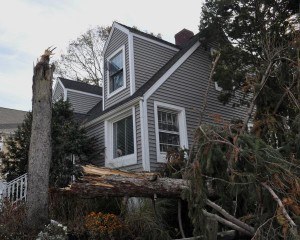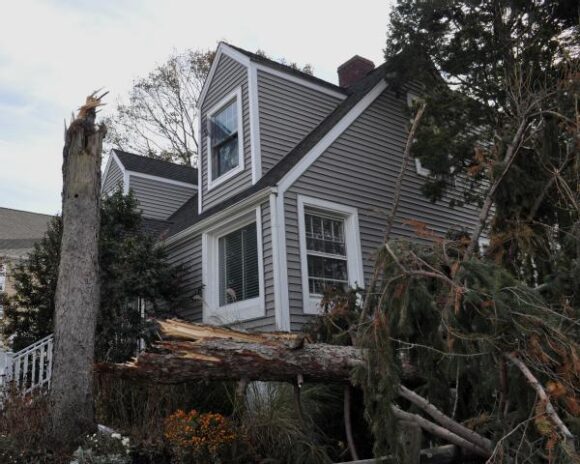They fell by the thousands, like soldiers in some vast battle of giants, dropping to the earth in submission to a greater force.
The winds of Superstorm Sandy took out more trees in the neighborhoods, parks and forests of New York and New Jersey than any previous storm on record, experts say.
Nearly 10,000 were lost in New York City alone, and “thousands upon thousands” went down on Long Island, a state parks spokesman said. New Jersey utilities reported more than 113,000 destroyed or damaged trees.
“These are perfectly healthy trees, some more than 120 years old, that have survived hurricanes, ice storms, nor’easters, anything Mother Nature could throw their way,” said Todd Forrest, a vice president at the New York Botanical Garden. “Sandy was just too much.”
As oaks, spruces and sycamores buckled, many became Sandy’s agents, contributing to the destruction by crashing through houses or tearing through electric wires. They caused several deaths, including those of two boys playing in a suburban family room. They left hundreds of thousands of people without power for more than a week.
And as homeowners and public officials deal with the cleanup, some tree care experts say the shocking force of the storm weeks ago might mean they should reassess where and how to replant.

“When trees go down that have lived a long life and been so beneficial, it’s terrible when they cause injury to people and property,” said Nina Bassuk, program leader at the Urban Horticulture Institute at Cornell University. “We have to replant better and do it smarter.”
For example, she said, shorter trees like hawthorns and crabapples should be planted below electric wires.
She also said a soil substitute can help trees extend their roots beneath pavement so maybe they can keep their balance in high winds.
Frank Juliano, executive director of the Reeves-Reed Arboretum in Summit, N.J., which lost uncounted trees on its perimeter, said those might not be replaced.
“Would they just come down again?” he asked. “This is a global issue. We all have to deal with the ramifications of what’s happening with our world and environment.”
But Bram Gunther, chief of forestry, horticulture and natural resources for the New York City Department of Parks & Recreation, said, “Some trees may have been planted where they shouldn’t have been and you have other infrastructure conflicts. You don’t stop planting trees.”
Gunther said last week that the city had counted 9,662 downed trees on its streets and in its parks after Sandy and the nor’easter that followed. That’s more than the combined total from tornadoes in 2010 and last year’s Hurricane Irene and October snowstorm.
Among those trees may be some New Yorkers’ favorites. Doug Blonsky, president of the Central Park Conservancy, said among the hundreds of Central Park trees that became Sandy’s victims were a popular 120-year-old swamp white oak near the Mall and a willow next to the Lasker pool.
Forrest said one of his favorite spots at the Botanical Garden, a valley in the protected forest, was changed forever when an American beech was blown over “and took out five or six other trees like a game of dominoes.”
The city has been in the midst of a campaign to plant 1 million trees. Gunther said the idea was to help with environmental issues such as greenhouse gases, air pollution and the urban heat island effect.
Forrest said it seems ironic that trees, “the very things that are supposed to help buffer climate change, are now examples of the havoc it can wreak.”
But he said, “That shouldn’t make us afraid of trees or less willing to plant trees.” He said each tree that came down was home to birds, insects and “animals you wouldn’t associate with New York City, like our great horned owls.”
He said at least 286 trees were uprooted or otherwise destroyed at the Bronx garden and 271 others were damaged enough that their survival is questionable.
“This is the most wholesale destruction of trees at the garden, especially in the native forest, on record,” he said. “It was worse than the great hurricane of 1944.”
On Long Island, “we were just destroyed,” said New York state parks spokesman Randy Simons, estimating “thousands upon thousands” of trees came down.
At the Planting Fields Arboretum, a state park in Oyster Bay on Long Island’s North Shore, director Vincent Simeone said, “We’re certainly not going to stop planting the way we plant, but we did learn that 70 mph winds seems to be the breaking point. With Irene, our trees did pretty well, but now we’ve got hundreds damaged or destroyed.”
He said he’s already planning for spring.
“Sometimes a tree falls and a vista opens up and you have an opportunity to do something different,” he said.
Larry Hajna, spokesman for New Jersey’s Department of Environmental Protection, said big stands of evergreens that were planted in the 1930s by the Civilian Conservation Corps toppled during Sandy.
“For 70, 80 years, they had no problems, but this storm came along and that was more than enough,” he said.
The Bartlett Arboretum in Stamford, Conn., is considering taking some drastic measures before the next big storm. It said last year it lost century-old chestnut trees and during Sandy a 100-foot-tall, 120-year-old white pine crashed down onto a cottage where a staffer was living.
“It was one of a matching pair, and now the other one is there and with all the trees we’ve lost the wind buffer is eliminated,” executive director Peter Saverine said. “We’re going to have to look at taking it down.”
“It’s sad, but we have to look ahead,” he said. “`In two years, we’ve had two 100-year storms and two freak snowstorms.”
Was this article valuable?
Here are more articles you may enjoy.


 JPMorgan Wins Gender Pay Gap Dispute Against London Analyst
JPMorgan Wins Gender Pay Gap Dispute Against London Analyst  OpenAI And Microsoft Sued Over Murder-Suicide Blamed on ChatGPT
OpenAI And Microsoft Sued Over Murder-Suicide Blamed on ChatGPT  Billionaire NFL Owner Suing Over Billboards Near His SoFi Stadium
Billionaire NFL Owner Suing Over Billboards Near His SoFi Stadium  Surging Oil Tanker Insurance Points to Growing Black Sea Chaos
Surging Oil Tanker Insurance Points to Growing Black Sea Chaos 